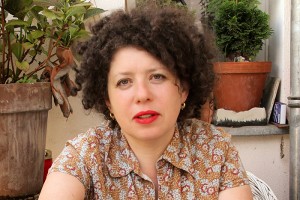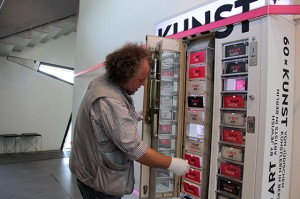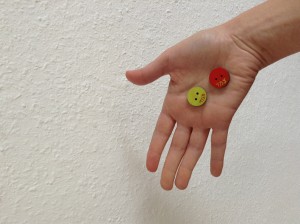With her works for our art vending machines, Deborah Wargon exposes things that got swept under the rug

Portrait of Deborah Wargon © Jewish Museum Berlin, photo: Gelia Eisert
A cordial welcome, the wafting flavors of a freshly-cooked meal, a light-drenched room with a high ceiling, full of brightly-colored books and pictures, and a piano with a sign-post ‘to Australia’ sitting on it… My first encounter with Deborah Wargon in her live-in atelier in Berlin’s Prenzlauer Berg neighborhood is a far cry from the rather severe, somber associations that the term ‘testament enforcer’ brings up for me. Wargon – a musician as well as visual and theater artist born in Melbourne in 1962 – describes herself this way on the package insert that comes with the small-scale artworks that she created for the art vending machine in our permanent exhibition. Those artworks bear the title “The Legacy of Friede Traurig” – where Friede Traurig doubles as a proper name and, in German, to mean peace sorrowful. And Deborah Wargon, who is best known for her paper cuttings inside former insect cases, says that she would rather be sorrowful.
With a little good luck, you may get one of her works from the vending machine: for instance, a little human figurine made of rail track ballast (gravel), wire, and newspaper. Aside from the expressive name Friede Traurig, the materials invoke woeful stories of train transports and barbed wire fences, particularly because the newspapers she used are from the Second World War. But for the artist, it’s clearly not only about the specific time the Nazis were in power and the Shoah. It’s also about the legacies, the inheritance, the stories that we all carry with us. She explains her choice of materials: “For me, wire is a fascinating material. It’s also used for cages. So you can use to suggest the ways that we’re all captive.” The rail track gravel, which normally lies on the ground, relates for Wargon to the ground that we all walk on, as descendants of the people who came before us. “Besides, in both German and English there’s the expression ‘to sweep something under the rug’”. The gravel, or grit, that we bring into the house on the soles of our shoes, and then sweep under the rug, stands for something that we don’t want to face and deal with.
→ continue reading
Handmade, for our Art Vending Machine

Jens Eisenberg (company Leitwerk) fills our art vending machine.
© Jewish Museum Berlin, photo: Gelia Eisert
Anyone who walks through the first floor of our permanent exhibition has inevitably stumbled across our ‘art vending machine.’ The machine almost seems to be whispering, in two languages, “Kauf mich, buy me.” Labels gleam colorfully from the compartments but you won’t notice more than that at first. If you get curious, though, and come closer, you will read the inscription, “Kunst / Art” in big typeface, and along the vending machine’s side, “60 x art by Jewish artists in Berlin.” Now you notice the coin slots, where you can put in your 4 euros.
With the right change in your pocket and a little audacity, you can start the experiment. → continue reading
An Interview with Lina Khesina
30 July 2014 is International Friendship Day. But how do we commemorate friendship? Or how do we make it visible? We consulted with communications designer Lina Khesina to find out. She devised a pair of ‘friendship buttons’ that you can get at the moment from the art vending machine in our permanent exhibition. One of them features the word “Tsemed” in Hebrew script, and the other one the word “Chemed.”

The buttons “Tsemed” and “Chemed”.
Photo courtesy of the artist
Lisa Albrecht: Lina, why did you develop this item in particular for the art vending machine?
I had the idea of showing the beauty of the Hebrew language and transmitting it in an everyday way. I don’t actually speak Hebrew myself, but purely from a musical perspective I find it and Spanish the two most beautiful languages. So I really wanted to discover Hebrew for myself and find a constellation of words in the language that I could play with. That’s how these buttons with the wordplay emerged.
How did the wordplay occur to you?
In Russian, best friends are often called “nje rasléj wodá”, which more or less means “even water cannot destroy this bond.” I did some research on whether there’s such an idiom in Hebrew as well and thus learned about “Tsemed Chemed.” Translated literally, it means “sweet entanglement” or “fine pair”, and is an expression for ‘close friends.’
What do these two words have to do with the buttons?
Buttons get sewed on with a thread and become then ‘entangled,’ or interwoven, with the material. Close friends experience something similar, even when they live thousands of kilometers apart. Like the buttons, they’re connected to each other by the thread and the adage. → continue reading


